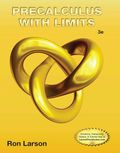
Concept explainers
a.
Find equation of parallel line.
a.
Answer to Problem 76E
Explanation of Solution
Given information:
Write equations of the lines through the given point parallel to given line.
Calculation:
Consider the given points on line.
The equation of line with slope
If the slopes of two non vertical lines are equal then lines are parallel.
If the slopes of two non vertical lines are negative reciprocal of each other then lines are perpendicular.
Now compare given line with standard equation of line,
Subtract
Now equation
According to above parallel line property any line parallel to considered line
By using point slope form equation,
Now multiply
Now add
Hence, the line through point
b.
Find equation of perpendicular line.
b.
Answer to Problem 76E
Explanation of Solution
Given information:
Write equations of the lines through the given point parallel to given line.
Calculation:
Consider the given points on line.
The equation of line with slope
If the slopes of two non vertical lines are equal then lines are parallel.
If the slopes of two non vertical lines are negative reciprocal of each other then lines are perpendicular.
According to the above perpendicular line property to the given line
So the line through point
By using point slope form equation
So
Multiply both side by
Add
Hence, the line through point
Chapter 1 Solutions
EBK PRECALCULUS W/LIMITS
- Explain the key points and reasons for the establishment of 12.3.2(integral Test)arrow_forwardUse 12.4.2 to determine whether the infinite series on the right side of equation 12.6.5, 12.6.6 and 12.6.7 converges for every real number x.arrow_forwarduse Cauchy Mean-Value Theorem to derive Corollary 12.6.2, and then derive 12.6.3arrow_forward
- Explain the focus and reasons for establishment of 12.5.1(lim(n->infinite) and sigma of k=0 to n)arrow_forwardExplain the focus and reasons for establishment of 12.5.3 about alternating series. and explain the reason why (sigma k=1 to infinite)(-1)k+1/k = 1/1 - 1/2 + 1/3 - 1/4 + .... converges.arrow_forwardExplain the key points and reasons for the establishment of 12.3.2(integral Test)arrow_forward
 Calculus: Early TranscendentalsCalculusISBN:9781285741550Author:James StewartPublisher:Cengage Learning
Calculus: Early TranscendentalsCalculusISBN:9781285741550Author:James StewartPublisher:Cengage Learning Thomas' Calculus (14th Edition)CalculusISBN:9780134438986Author:Joel R. Hass, Christopher E. Heil, Maurice D. WeirPublisher:PEARSON
Thomas' Calculus (14th Edition)CalculusISBN:9780134438986Author:Joel R. Hass, Christopher E. Heil, Maurice D. WeirPublisher:PEARSON Calculus: Early Transcendentals (3rd Edition)CalculusISBN:9780134763644Author:William L. Briggs, Lyle Cochran, Bernard Gillett, Eric SchulzPublisher:PEARSON
Calculus: Early Transcendentals (3rd Edition)CalculusISBN:9780134763644Author:William L. Briggs, Lyle Cochran, Bernard Gillett, Eric SchulzPublisher:PEARSON Calculus: Early TranscendentalsCalculusISBN:9781319050740Author:Jon Rogawski, Colin Adams, Robert FranzosaPublisher:W. H. Freeman
Calculus: Early TranscendentalsCalculusISBN:9781319050740Author:Jon Rogawski, Colin Adams, Robert FranzosaPublisher:W. H. Freeman
 Calculus: Early Transcendental FunctionsCalculusISBN:9781337552516Author:Ron Larson, Bruce H. EdwardsPublisher:Cengage Learning
Calculus: Early Transcendental FunctionsCalculusISBN:9781337552516Author:Ron Larson, Bruce H. EdwardsPublisher:Cengage Learning





